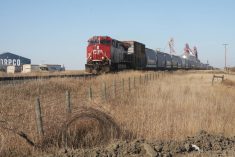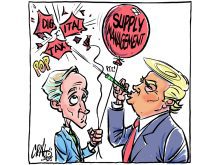Agriculture, particularly livestock, has been getting a public relations strafing of late.
Various factions in the climate change debate have been on the offensive, trying to claim the high ground leading to a United Nations climate change meeting in Copenhagen Dec. 7-18. That conference aims to recommend specific limits on greenhouse gas emissions.
As a contributor to greenhouse gas (GHG) emissions, agriculture must be part of meaningful climate change discussions, but how much it contributes depends on who you ask.
The Worldwatch Institute, an environmental advocacy group, says the livestock sector accounts for more than half of all GHG produced through human activity.
Read Also

Agriculture needs to prepare for government spending cuts
As government makes necessary cuts to spending, what can be reduced or restructured in the budgets for agriculture?
The United Nations Food and Agriculture Organization attributes 18 percent of GHGs to livestock in an oft-cited 2006 report.
The University of California at Davis credits livestock emissions with three percent of GHGs.
The discrepancies can be attributed to differences in how researchers assess the effects of methane, the amount of carbon dioxide in livestock respiration and carbon fixation in soil.
Researchers also differ on how much GHG to attribute to livestock when most emissions are actually caused by land clearing in developing nations and not by the animals themselves.
The wild variation has many wondering what a good global citizen is supposed to do.
We do know we are going to have to feed 9.1 billion people by 2050, while also reducing the carbon footprint.
Faced with such an overwhelming task, it is no wonder people cling to simplistic answers like those offered by former World Bank chief economist Nicholas Stern.
When Stern suggested that people give up eating meat to fight climate change, it was licked up by some people like sweet, healing nectar – not because such a “remedy” would work, but because it offered an easy course of action to a problem that has made us feel helpless for a long time.
Getting an accurate measurement on livestock GHG emissions depends on so many judgments that politics play as great a role as science. For example, cattle fed in a feedlot system are said to emit more gas than cattle grazing pastures.
But a study from Washington State University suggested cattle finished on pasture emit more GHG because it takes them longer to reach slaughter weight.
That’s why it is vital we learn to see through snake oil sales pitches – those proposed solutions that have no basis.
Suppose western countries tomorrow issued laws against eating meat. What do people turn to for food?
Would marginal land used for forages and grazing turn into cropland?
Would we see more destruction of the rainforest? What about the carbon footprint caused by western nations forced to import more food?
Or do people turn to the sea to feed themselves, further stressing already threatened ocean fish stocks?
With livestock production predicted to double by 2050 to feed the ever increasing human population, the world must find ways to raise animals more efficiently.
To that end, governments and policy makers must find incentives to help agriculture adapt. Agriculture research into improved bovine digestion, healthier meat and more digestively efficient sources of feed are all promising. Rather than trying to get rid of livestock production entirely, a more reasonable path is to make livestock production more sustainable.
The new systems that arise may not be what environmental activists envision, but science and efficiencies of scale will best serve the planet.
It is important that all in the agricultural industry throw themselves into the debate now to ensure that science trumps politics and emotion at Copenhagen.
Bruce Dyck, Terry Fries, Barb Glen, D’Arce McMillan and Ken Zacharias collaborate in the writing of Western Producer editorials.
















